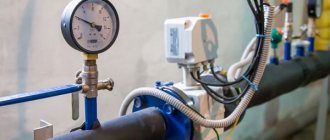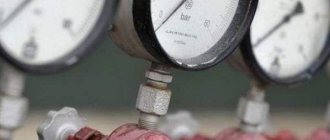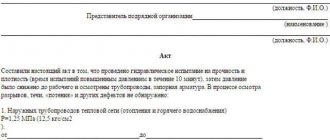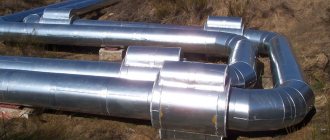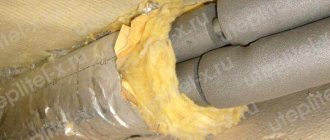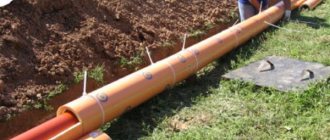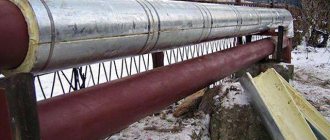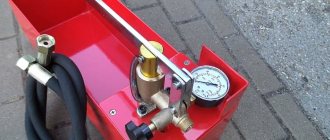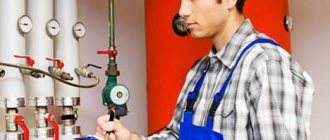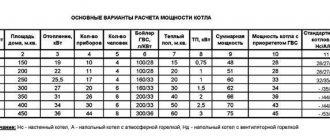INTERNAL COLD AND HOT WATER SUPPLY SYSTEMS
4.4. Internal cold and hot water supply systems must be tested by hydrostatic or manometric method in compliance with the requirements of GOST 24054-80, GOST 25136-82 and these rules.
The test pressure value for the hydrostatic test method should be taken equal to 1.5 excess operating pressure.
Hydrostatic and pressure testing of cold and hot water supply systems must be carried out before installing water taps.
Systems are considered to have passed the tests if, within 10 minutes of being under test pressure using the hydrostatic test method, no pressure drop of more than 0.05 MPa (0.5 kgf/cm2) and drops in welds, pipes, threaded connections, fittings and water leaks are detected through flushing devices.
At the end of the hydrostatic test, it is necessary to release water from the internal cold and hot water supply systems.
4.5. Manometric tests of the internal cold and hot water supply system should be carried out in the following sequence: fill the system with air at a test excess pressure of 0.15 MPa (1.5 kgf/cm2); if installation defects are detected by ear, the pressure should be reduced to atmospheric pressure and the defects eliminated; then fill the system with air at a pressure of 0.1 MPa (1 kgf/cm2), maintain it under test pressure for 5 minutes.
The system is considered to have passed the test if, when it is under test pressure, the pressure drop does not exceed 0.01 MPa (0.1 kgf/cm2).
Step-by-step instructions for an independent procedure for cleaning the coolant
It is possible to clean the artificial heating system of a building without a third party. To do this, you will need a pneumatic diaphragm pump capable of raising pressure above 6 atmospheres. Before starting the operation, you need to turn off all the valves and unscrew the radiator end caps with a wrench.
Algorithm:
- Close the resource drain valve.
- Connect the diaphragm pump to the valve located after the shut-off valve.
- Dispose of waste coolant.
- Turn on the membrane pump, raise the pressure to 6 at.
- Open the system valve.
- Turn off all house heating risers one by one. No more than 10 residential highways should be closed per run.
After the operation, you need to connect the pump through the return line to the carrier inlet into the building. However, before this it is necessary to drain the heating. After high-quality treatment of the circuit, the water should come out clear.
HEATING AND HEAT SUPPLY SYSTEMS
4.6. Testing of water heating and heat supply systems must be carried out with the boilers and expansion vessels turned off using the hydrostatic method with a pressure equal to 1.5 working pressure, but not less than 0.2 MPa (2 kgf/cm2) at the lowest point of the system.
The system is considered to have passed the test if, within 5 minutes of being under test pressure, the pressure drop does not exceed 0.02 MPa (0.2 kgf/cm) and there are no leaks in welds, pipes, threaded connections, fittings, heating devices and equipment.
The test pressure value using the hydrostatic test method for heating and heat supply systems connected to heating plants must not exceed the maximum test pressure for heating devices and heating and ventilation equipment installed in the system.
4.7. Manometric tests of heating and heat supply systems should be carried out in the sequence specified in clause 4.5.
4.8. Surface heating systems must be tested, usually using the hydrostatic method.
Manometric testing can be carried out at negative outdoor temperatures.
Hydrostatic testing of panel heating systems must be carried out (before sealing the installation windows) with a pressure of 1 MPa (10 kgf/cm2) for 15 minutes, while the pressure drop is allowed no more than 0.01 MPa (0.1 kgf/cm2).
For panel heating systems combined with heating devices, the test pressure value should not exceed the maximum test pressure for the heating devices installed in the system.
The test pressure value of panel heating systems, steam heating and heat supply systems during manometric tests should be 0.1 MPa (1 kgf/cm2). Test duration – 5 minutes. The pressure drop should be no more than 0.01 MPa (0.1 kgf/cm2).
4.9. Steam heating and heat supply systems with operating pressure up to 0.07 MPa (0.7 kgf/cm2) must be tested by the hydrostatic method with a pressure equal to 0.25 MPa (2.5 kgf/cm2) at the lowest point of the system; systems with a working pressure of more than 0.07 MPa (0.7 kgf/cm2) - hydrostatic pressure equal to the working pressure plus 0.1 MPa (1 kgf/cm2), but not less than 0.3 MPa (3 kgf/cm2) in the highest point of the system.
The system is recognized as having passed the pressure test if, within 5 minutes of being under test pressure, the pressure drop does not exceed 0.02 MPa (0.2 kgf/cm2) and there are no leaks in welds, pipes, threaded connections, fittings, or heating devices.
Steam heating and heat supply systems, after hydrostatic or pressure testing, must be checked by starting steam at the operating pressure of the system. In this case, steam leaks are not allowed.
4.10. Thermal testing of heating and heat supply systems at positive outside temperatures must be carried out at a water temperature in the supply lines of the systems of at least 333 K (60 °C). In this case, all heating devices should warm up evenly.
If there are no heat sources during the warm season, a thermal test of heating systems must be carried out upon connection to a heat source.
Thermal testing of heating systems at negative outside air temperatures must be carried out at a coolant temperature in the supply pipeline corresponding to the outside air temperature during testing according to the heating temperature schedule, but not less than 323 K (50 °C), and the circulating pressure in the system according to the working documentation .
Thermal testing of heating systems should be carried out within 7 hours, while checking the uniformity of heating of the heating devices (to the touch).
When is pressure testing carried out?
Work related to testing and checking the system is carried out in the following cases:
- upon completion of installation and commissioning of the system;
- after repair of any heating device;
- when replacing parts of the pipeline;
- in preparation for the heating season.
By the nature of the test work, crimping is a leak test. What it is?
They measure the instantaneous speed of each wheel and, in the event of braking, the deceleration of each tire is calculated to assess its propensity to lock up. Once the danger has passed, the original pressure will be restored. Acceleration This is a quantity that relates the change in speed to time and is measured in meters per second squared. This is the result of averaging measurements in both directions of acceleration to the vehicle's maximum capability on a solid horizontal reference. When the speed decreases, we talk about negative acceleration.
Let's say that this procedure involves the following actions:
supplying the system with water or air under pressure using a hydraulic or pneumatic pump;
- identification of system leaks;
- determining where water or air has penetrated the system.
Modern systems make it possible to carry out such tests without involving a large number of personnel. Violations of tightness are determined by special equipment.
Who carries out the pressure testing
Intake This is the first time in the four-stroke engine cycle during which air is introduced into diesel engines or a mixture of air and gasoline in the cylinders. The suction created by the piston as it descends forces the mixture or fuel into the cylinder. When the intake timing does not match the point indicated on the engine diagram, it is referred to as delayed intake. In this case, the piston begins to descend when the intake valve is not yet open. During this cycle, the crankshaft rotates half a turn.
When excess pressure is created inside the system, faulty devices, components and emergency areas will become unusable. The performance of suitable system elements does not suffer from such testing.
Sequence of work
Pressure testing and flushing of heating systems is carried out after turning off the entire system and removing the coolant (water or antifreeze) from it. When carrying out such a check, it becomes necessary to monitor pressure indicators to prevent rupture of the main pipeline.
It's handy to know that there is a variable intake type that is increasingly being used that is used to improve cylinder filling regardless of rotation speed. There are two types of variable intake manifolds: the most widely used are multi-plane variable-length machines, in which electronically controlled butterflies regulate air flow or mixture so that long and narrow ports are used at low speeds, rotating, wide and short when the rhythm is brighter.
Thus, the length to diameter ratio of the pipeline decreases as the linear speed of the piston increases. The second type is resonant variable intake manifolds, in which the pressure waveforms are synchronized when air in the manifold hits a closed valve. By controlling said wave selections so that they are pushed towards each other just as the valve is about to open, the filling of the cylinders is improved.
What features of the heating system are taken into account when determining specific test parameters:
- pipeline characteristics (material, wall thickness);
- characteristics of fittings;
- number of floors;
- type of wiring.
Pressure testing and flushing of the heating system includes the following preparatory work:
Airbag Airbag in English. In a severe crash, this airbag inflates for 30 thousandths of a second or less on the occupant - or their side in the case of side airbags - to prevent them from being hit by hard parts of the car's interior. The bag deflates again in tenths of a second once its cushioning mission has been achieved. The system is activated when a series of deceleration sensors detect that an accident has occurred. Thus, the signal is sent to the electronic control unit, which is responsible for activating the mechanism.
- prevention and preparation of the system;
- directly carrying out work to create pressure inside the system;
- preparation of documentation on the work performed;
- flushing the entire heating system.
BOILER HOUSES
4.11. Boilers must be tested using the hydrostatic method before lining work is carried out, and water heaters - before applying thermal insulation. During these tests, the heating and hot water supply systems must be disconnected.
Upon completion of hydrostatic tests, it is necessary to release water from boilers and water heaters.
Boilers and water heaters must be tested under hydrostatic pressure along with the fittings installed on them.
Before hydrostatic testing of the boiler, the covers and hatches must be tightly closed, the safety valves are jammed, and a plug must be placed on the flange connection of the flow device or bypass closest to the steam boiler.
The test pressure value for hydrostatic tests of boilers and water heaters is accepted in accordance with the standards or technical specifications for this equipment.
The test pressure is maintained for 5 minutes, after which it is reduced to the maximum operating pressure, which is maintained for the entire time required to inspect the boiler or water heater.
Boilers and water heaters are recognized as having passed the hydrostatic test if:
during the time they were under test pressure, no pressure drop was observed;
There were no signs of rupture, leakage or surface sweating.
4.12. Fuel oil pipelines should be tested with a hydrostatic pressure of 0.5 MPa (5 kgf/cm2). The system is considered to have passed the test if, within 5 minutes of being under test pressure, the pressure drop does not exceed 0.02 MPa (0.2 kgf/cm2).
Similar materials on the company website
E-25-1.4-225KB (E-25-1.4-225DWU) - Steam boiler Technical characteristics of E-25-1.4-225KB (E-25-1.4-225DWU) Type: Steam boiler Fuel : coal Nominal steam production,...
Flame - Burners LLC DESIGN PRESTIGE Heating water supply boiler room 8(495)744-67-74 Heating repair Water supply repair...
Which pipes are better, metal-plastic or polypropylene? Advantages of polypropylene pipes. If you are faced with the choice of what to buy metal-plastic...
INTERNAL SEWERAGE AND DRAINS
4.13. Testing of internal sewerage systems must be carried out by pouring water by simultaneously opening 75% of the sanitary fixtures connected to the area being tested for the time required for its inspection.
The system is considered to have passed the test if, during its inspection, no leaks were detected through the walls of the pipelines and joints.
Tests of sewer outlet pipelines laid in the ground or underground channels must be carried out before they are closed by filling them with water to the level of the ground floor floor.
4.14. Tests of sections of sewerage systems hidden during subsequent work must be carried out by pouring water before they are closed with the drawing up of an inspection report for hidden work in accordance with mandatory Appendix 6 of SNiP 3.01.01-85.
4.15. Internal drains should be tested by filling them with water to the level of the highest drain funnel. The duration of the test must be at least 10 minutes.
Drains are considered to have passed the test if no leaks are found during inspection and the water level in the risers has not decreased.
Pneumatic and hydraulic pressure testing of pipes: how it is done
Pressure testing of a pipeline is a technological operation performed on a relatively small isolated section of the pipeline. This section is specially tested by applying high pressure, close in value to the maximum permissible. Carrying out pressure testing of pipelines allows you to verify the integrity of the line, the quality of installation work and installation of fittings.
Pressure testing is a necessary and important operation that allows you to identify weak points in the assembled pipeline
Necessity
Despite the fact that most consumers who have a centralized heating system in their homes are accustomed to the fact that pressure testing is carried out in the summer, it is recommended to carry it out twice a year.
In addition, crimping is carried out in the following cases:
- Do-it-yourself pressure testing can be carried out at any time if there are suspicions about the integrity of the system, for example, rust on the pipes, their bending, etc.
- According to the rules of SNIP, pressure testing of the heating system is necessary when putting it into operation, for example, in new buildings or after major repairs with the replacement of pipes.
- If necessary, sewer risers can be pressure tested to identify defects. Considering that the sewer system is usually gravity-fed, a small leak does not cause problems until the riser becomes clogged or the water intake level is exceeded.
- In some cases, control pressure testing is carried out to resolve controversial issues, for example, when filing a civil lawsuit against neighbors who flooded as a result of burst pipes. In this case, a pressure test certificate for the heating system is issued, the form of which is certified by specialists and handed over to the judicial commission.
Do-it-yourself washing
Flushing heating systems is necessary to eliminate excess debris inside it. Recommendations, according to SNIP, suggest flushing the system at least once per heating season. This allows you to keep the inner surface of pipes and radiators clean and, as a result, improve their thermal conductivity and coolant circulation. Ideally, it is recommended to remove them to wash the batteries, but in extreme cases, you can use a pump. It is not difficult to assemble a pump for pressure testing the system with your own hands; in general, you can use any circulation pump that works with liquid, and a pressure gauge measuring pressure is not needed for flushing.
Flushing heating systems is necessary to eliminate excess debris inside it. Recommendations, according to SNIP, suggest flushing the system at least once per heating season.
Dirty pipes in the heating system
For flushing, the pump is connected on the back side of the battery against the normal circulation of the coolant; this improves the flushing results due to the fact that the scale formed inside the pipe is deposited in the form of scales directed along the flow of the coolant.
Methods
Currently, washing is carried out in several ways according to OKPD:
- The chemical cleaning method involves the use of acids and alkaline solutions.
- Electric pulse cleaning - electrical discharge occurs in the water, which leads to the destruction of scale and its subsequent removal by regular washing.
- OKPD provides for washing batteries with water hammer, which is created by a special apparatus.
Regulatory rules for conducting hydropneumatic tests
The rules for carrying out such work are determined by regulatory documents - SNiP (building codes and regulations).
These standards regulate certain technological schemes and instructions, taking into account the specifics of work from the point of view of compliance with safety regulations, and also define equipment for pressure testing of the heating system.
These standards regulate certain technological schemes and instructions, taking into account the specifics of work from the point of view of compliance with safety regulations, and also define equipment for pressure testing of the heating system.
Hydraulic tests must be preceded by flushing and preparation of the main pipeline of the heating system. Flushing is carried out in various ways and aims to remove scale and deposits of various salts and other chemical compounds from the internal walls of pipes in the system. A compressor is used for this.
Composition of deposits on the walls of pipes of heating systems (in decreasing order):
- ferrous oxide;
- magnesium oxide;
- calcium oxide;
- copper oxide;
- zinc oxide;
- trivalent sulfur oxide.
Important! Flushing should be carried out every 5-7 years of operation of the heating system. This will make the operation of the entire system more reliable and of higher quality.
What is the practical meaning of such a flush? During operation, heating efficiency is significantly reduced due to plaque and deposits on the pipes.
The flow diameter of pipes is reduced by almost half due to deposits and scale. This all leads to breakdowns and disruptions to proper operation. Due to scale and deposits, the quality of water circulation decreases.
The flow diameter of pipes is reduced by almost half due to deposits and scale. This all leads to breakdowns and disruptions to proper operation.
